"건축은 공간을 통해 시를 쓰는 것이다. 모든 공간은 그 안에 담긴 빛과 그림자, 소리와 침묵으로 이야기를 들려준다." - 루이스 바라간

 |
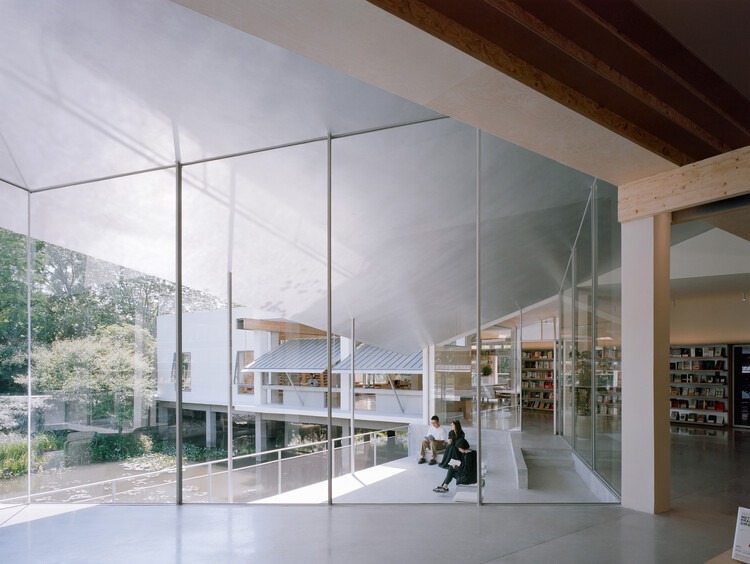 |
 |
아뜰리에 웬아치 - 시시 골드마이 북스토어 Atelier Wen'Arch-Xixi Goldmye Bookstore
시시 습지 푸디 북쪽 출발점에 자리한 이 프로젝트는 20년 된 사무동이 품고 있던 이야기를 완전히 새로 써내려간다. U자형 대칭 구조로 설계된 원래 건물은 복잡하게 얽힌 기능 공간들을 하나의 덩어리 안에 담고 있었다. 습지 위로 떠오른 이 건물은 세 개의 날개로 둘러싸인 폐쇄적이고 움츠린 물뜰을 중심에 두고 있었다. 새로운 설계는 외관 리노베이션과 내부 설계를 통해 이곳을 서점으로 탈바꿈시키는 것이었다.
물을 품은 수평적 공간의 탄생
1층은 물뜰을 감싸 안는 수평적으로 연결된 공간으로 계획되었다. 서쪽의 종축 메인 공간은 책 진열과 판매 구역을 담고, 북쪽 날개는 커피와 독서가 어우러진 휴식 공간으로 거듭났다. 남쪽 날개에는 독서 살롱이 들어서며, 외부 계단을 통해 2층 조경 테라스와 자연스럽게 이어진다. 이는 한국 전통 건축의 마루가 내외부를 자연스럽게 연결하던 방식을 현대적으로 재해석한 것이라 할 수 있다.
모든 둘러싼 벽을 걷어낸 자리에는 무질서하고 의미를 잃은 콘크리트 프레임 구조들만이 남았다. 여기에 일련의 새로운 구조체들이 개입하면서 원래의 혼란스런 구조에 새로운 질서를 부여하고, 자연과 깊이 연결된 공간의 장들로 변모시켰다.
기존 골조의 해체와 재구성
원래의 복잡한 지붕 보와 슬래브에 대응하여 설비를 수용하는 천장 시스템을 도입해 이들을 재정리했다. 기존 골조는 어긋나게 배치된 볼륨들을 지탱하는 기둥들의 숲으로 해체되었다. 서쪽 지붕 볼륨의 간결한 조정과 파사드의 후퇴된 주랑(기둥이 일렬로 늘어선 복도)은 원래 대칭적인 중심축 구성을 수평적으로 떠오르는 볼륨으로 바꾸어, 건물의 공공성을 한층 강화했다.
기존 메인 출입구 플랫폼의 곡선형 진입로 위에는 콘크리트 스트립으로 만든 엇갈린 각도의 보행로가 깔렸다. 이를 통해 원래의 차량 플랫폼은 다양한 스케일과 변화하는 방향성을 가진 입구 공간으로 변모했다.
목재 빔의 재건축
기존 6×6미터 구조 그리드에 대응하여 목재 더블빔 시스템을 도입했다. 각각의 목재 더블빔은 콘크리트 기둥들의 열을 연속적으로 잡아주며, 물뜰에 수직인 수평적 공간 질서를 구축하고 U자형의 내부와 외부를 연결한다.
구조용 집성 소나무 빔들은 숨겨진 플레이트 조인트를 통해 콘크리트 기둥에 구조적으로 정착되면서, 다양한 지점에서 외부로 캔틸레버(한쪽 끝만 지지되어 돌출된 구조)된다. 더블빔 사이의 틈새는 공조 리턴과 기둥 정렬 조명을 위한 통합 채널 역할도 한다. 목재 빔이 형성하는 수평적 공간의 장에 설계는 두 개의 수직적 공간 교란을 추가로 도입한다. 하나는 천창으로 이어지는 북타워이고, 다른 하나는 습지로 향하는 물가 파빌리온으로, 자연 풍경이 서점 공간과 더욱 입체적으로 만나게 한다.
솟아오른 북타워
남서쪽 모서리의 높은 볼륨 안에 북타워가 삽입되었다. 쌓이고 중첩된 중층부의 두 개 링은 단면에서 극장 같은 패턴을 형성한다. 어긋난 레벨들은 다양한 높이에서 앉아서 책을 읽는 공간들을 만들어내고, 동쪽을 향한 창은 습지의 먼 녹음을 액자처럼 담아낸다.
북타워 내부의 중층부는 기존 바닥판의 관례적 처리를 벗어난다. 콘크리트 기둥들 사이에 십자 배치된 철골 빔들의 그리드가 매달려 중층부 구조를 형성한다. I빔의 상부면은 목재 바닥재와 같은 높이로 맞춰져, 목재 빔들과 같은 재료적 질감을 공유하는 수평적 요소로 시각적으로 읽힌다. 종축 공간의 끝에서 빔들은 층층이 내려오며 자연광을 끌어들인다. 북타워 안에서 사람들의 실루엣은 수평적 목재 빔들에 포착되어 떠오르는 풍경이 된다.
Write by Claude & Jean Browwn
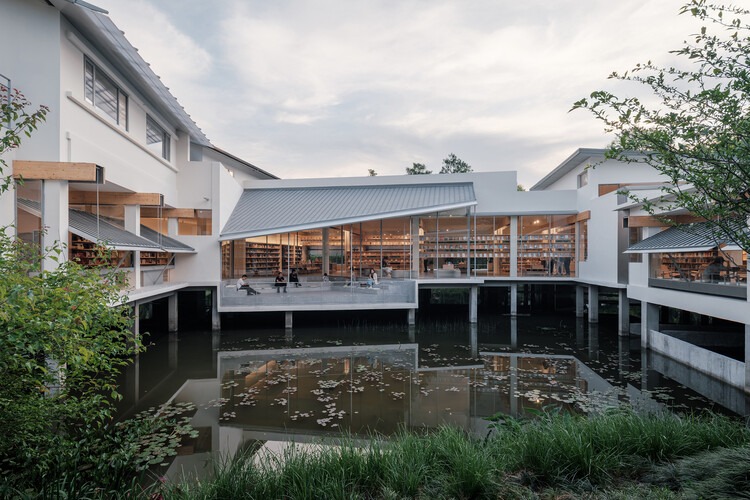
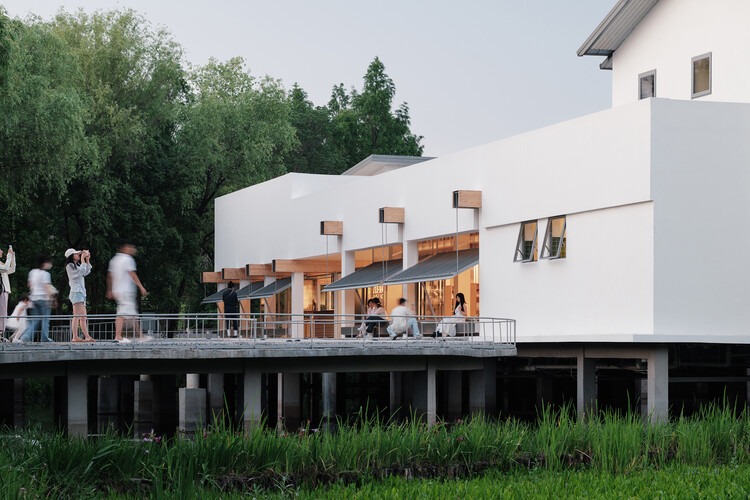

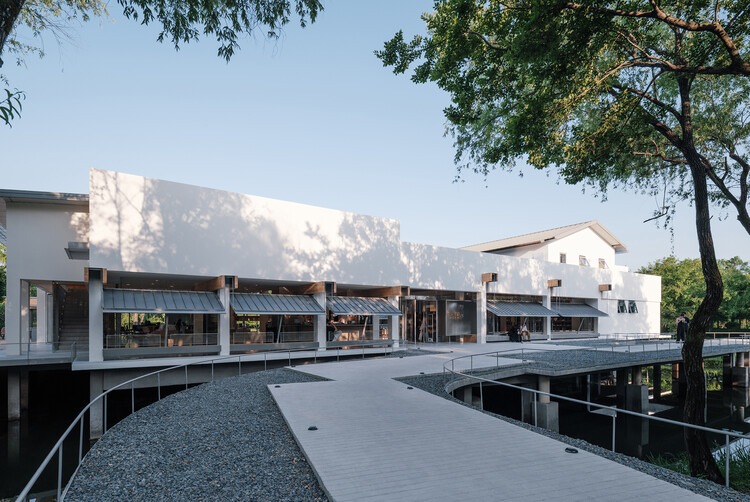
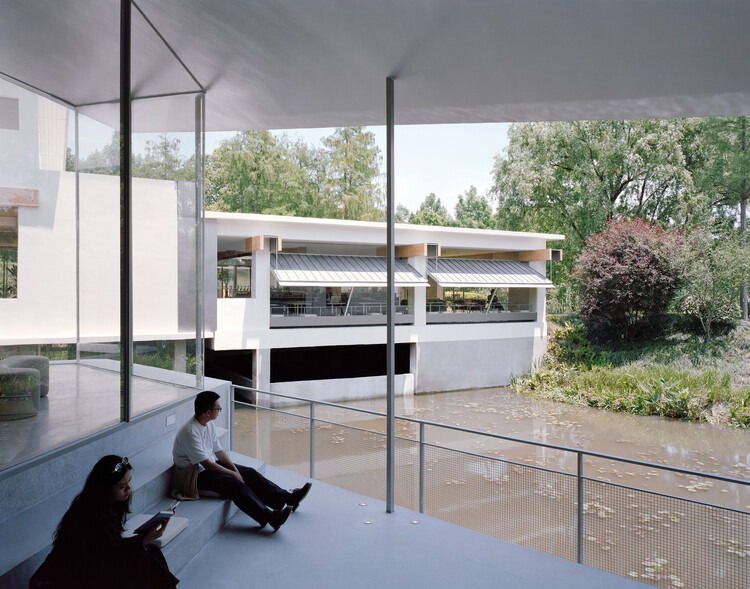
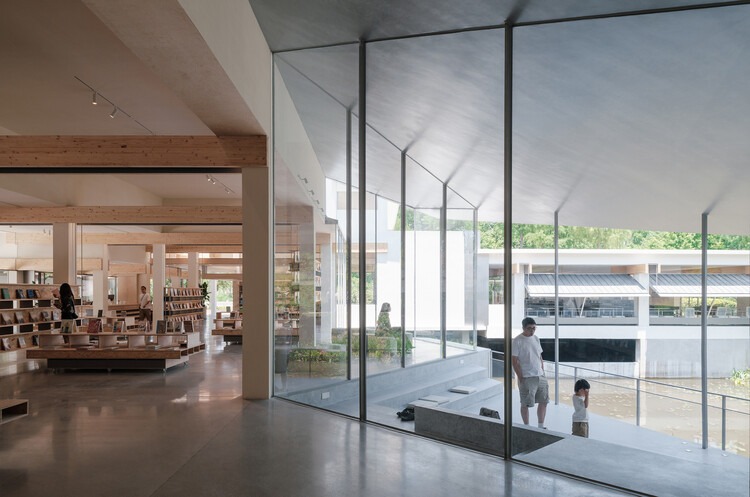

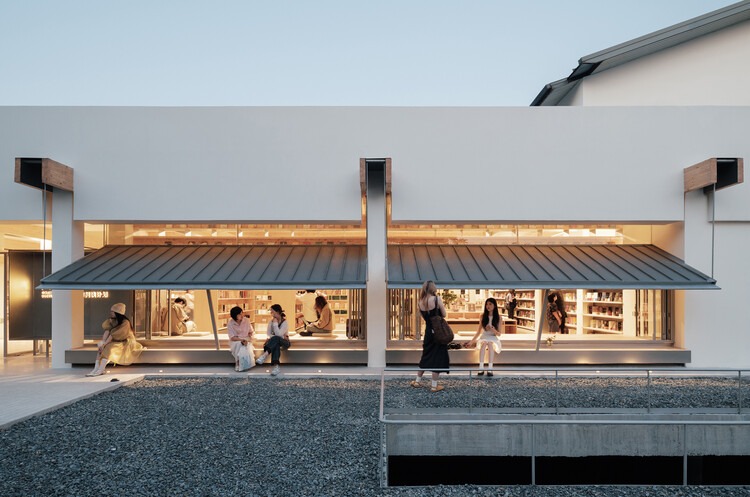





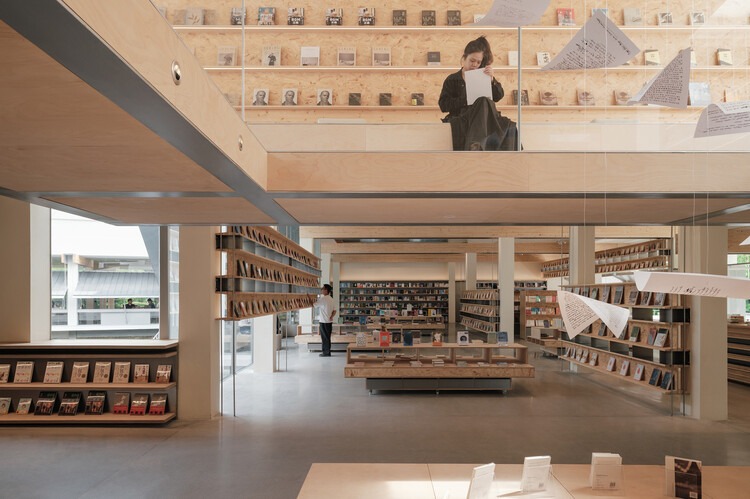
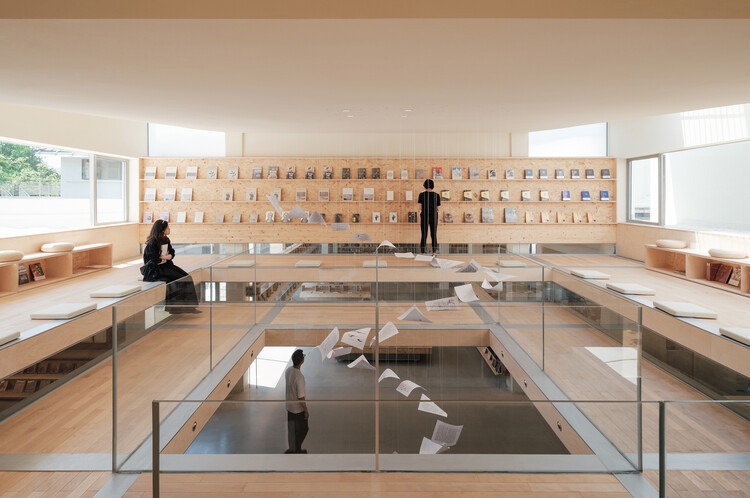

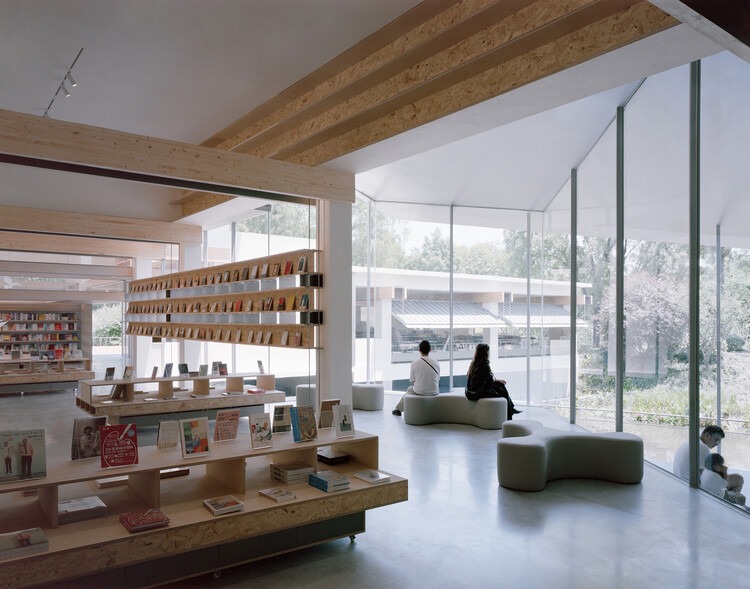

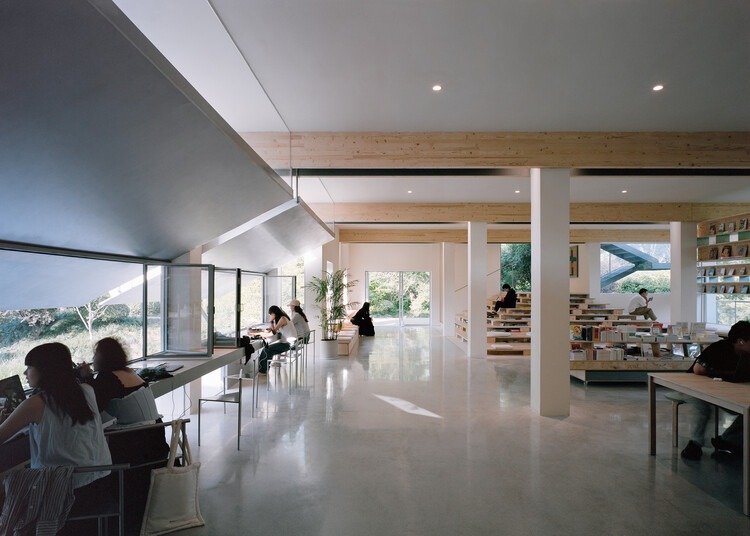
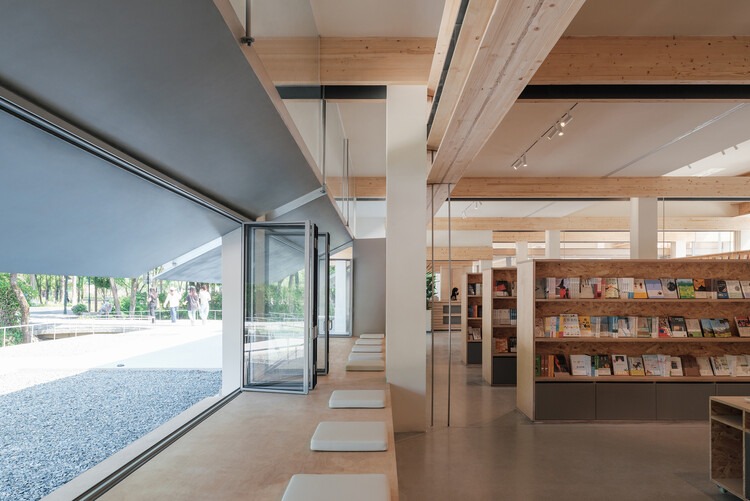
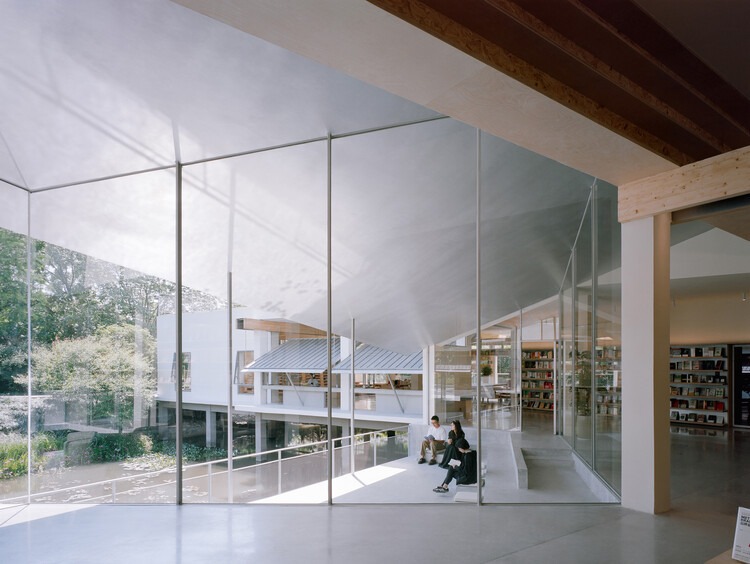
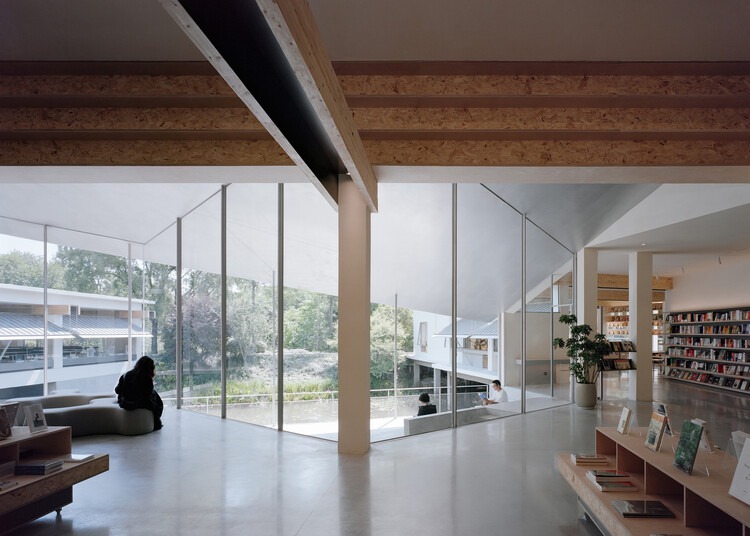
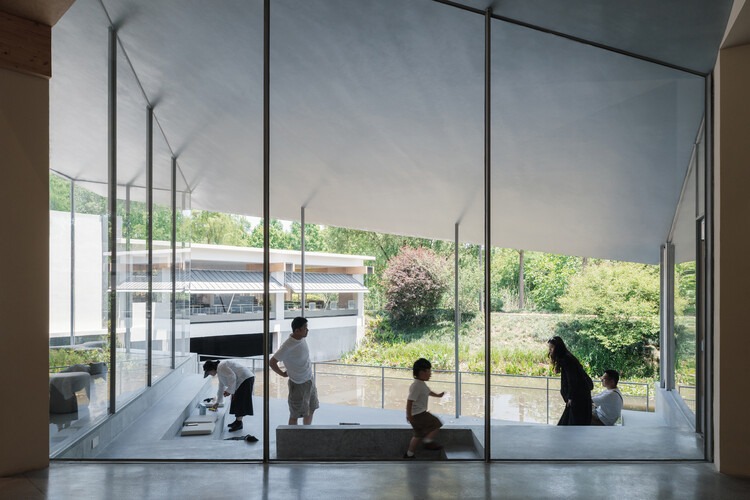

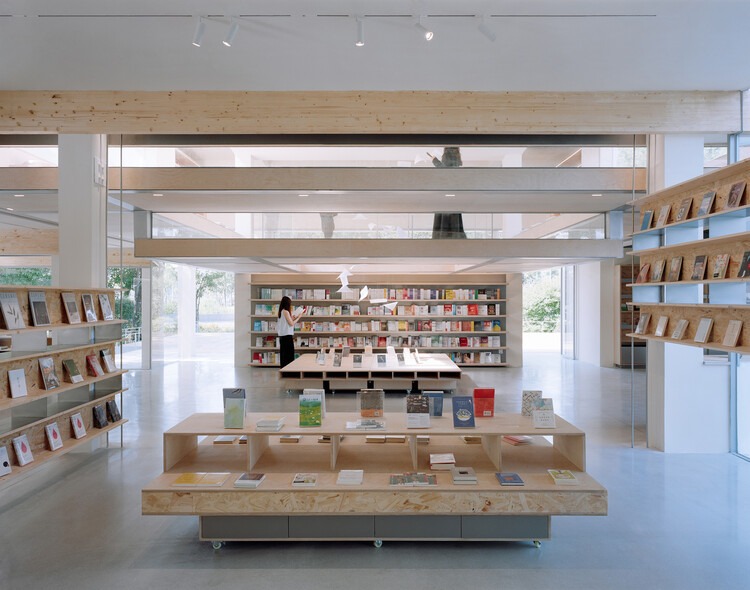



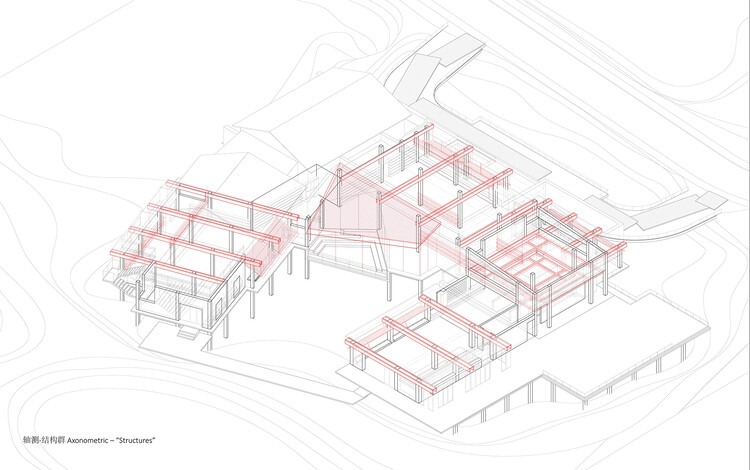

The project is located at the northern starting point of Fudi, Xixi Wetland. The original building was an office building twenty years ago - a U shaped symmetrical layout with a combination of functional spaces in an intricate volume. The building is elevated above the wetland, with a closed and negative water courtyard surrounded by three wings. The design required a façade renovation and interior design to transform it into a bookstore.
The first floor is planned as a horizontally connected space that embraces the water courtyard. The longitudinal main space on the west side houses the book display and sale area, while the north wing serves as a coffee reading area. The south wing accommodates a reading salon, which connects to the landscaped terrace on the second floor via an external staircase. Stripped of all enclosing walls, what remains is a set of disordered and meaningless concrete frame structures. The intervention of a series of new "structures" imposes a new order to the originally chaotic structure, transforming it into spatial fields which are deeply connected to nature.
Disintegration of the Original Framework — In response to the original complex roof beams and slabs, a ceiling system accommodating MEP equipment was introduced to reorganize them. The original framework was disintegrated into a forest of standing columns supporting the staggered volumes. The simplified adjustment of the roof volume on the west side, along with the recessed colonnade on the façade, transforms the originally symmetrical central axis composition into a horizontally floating volume, thereby enhancing the building's sense of publicness. On the existing curved driveway of the main entrance platform, a staggered-angle pedestrian walkway made of concrete strips has been laid, transforming the original vehicular platform into an entrance space with varied scales and shifting orientations.
Reconstruction of the Timber Beams — In response to the original 6×6 meter structural grid, a timber double beam system was introduced. Each timber double-beam continuously clamps the rows of concrete columns, establishing a horizontal spatial order that is perpendicular to the water courtyard and connects the inside and outside of the U-shape.
The structural glued laminated pine beams are structurally anchored to the concrete columns via concealed plate joints, while cantilevering outward at various points. The gaps between the double beams also serve as integrated channels for air-conditioning return and column aligned lighting. In the horizontal spatial fields formed by the timber beams, the design further introduces two vertical spatial disturbances: one is the book tower leading to the skylight, and the other is the waterside pavilion leading to the wetland, enabling the natural landscape to engage with the bookstore space in a more three-dimensional way.
The Elevated Book Tower — A "Book Tower" is inserted into the tall volume at the southwest corner. The two rings of stacked and nested mezzanines form a theater-like pattern in section. The staggered levels create sit-and read spaces at varying heights, while the window facing east frames distant views of greenery from the wetland.
The mezzanine within the book tower breaks the conventional treatment of floor slabs. A grid of steel beams in a crisscross layout is suspended between the concrete columns to form the mezzanine structure. The top surfaces of the I beams are flush with the wooden flooring, allowing them to visually read as horizontal elements that share the same material quality as the timber beams. At the end of the longitudinal space, the beams cascade downward in layered sequences, channeling natural light. Within the book tower, the silhouettes of people are captured by the horizontal timber beams and become a floating scenery.
from archdaily